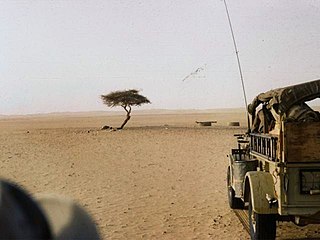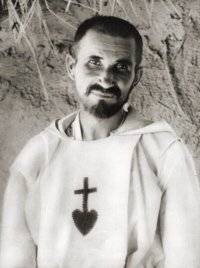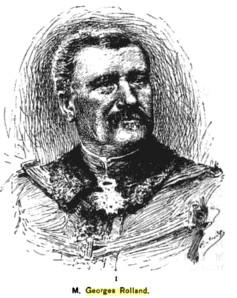
The Tuareg languages constitute a group of closely related Berber languages and dialects. They are spoken by the Tuareg Berbers in large parts of Mali, Niger, Algeria, Libya and Burkina Faso, with a few speakers, the Kinnin, in Chad.

The Ténéré Tree was a solitary acacia, of either Acacia raddiana or Acacia tortilis, that was once considered the most isolated tree on Earth—the only one for over 150 kilometres (93 mi). It was a landmark on caravan routes through the Ténéré region of the Sahara Desert in northeast Niger, so well known that it and the Arbre Perdu to the north are the only trees to be shown on a map at a scale of 1:4,000,000. The Tree of Ténéré was located near a 40-metre (130 ft) deep well. It was knocked down in 1973 by a truck driver.

Charles Eugène de Foucauld was a cavalry officer in the French Army, then an explorer and geographer, and finally a Catholic priest and hermit who lived among the Tuareg in the Sahara in Algeria. He was assassinated in 1916 and is considered by the Church to be a martyr. His inspiration and writings led to the founding of the Little Brothers of Jesus among other religious congregations.
Tetserret is a Western Berber language spoken by the Ait-Awari and Kel Eghlal Tuareg tribes of the Akoubounou (Akabinu) commune in Niger. This main speech area is located between Abalak, Akoubounou and Shadwanka. The variant spoken by the Kel Eghlal is called taməsəɣlalt. The Tamasheq equivalent shin-sart / shin-sar / tin-sar is used in some older literature. Popular understanding among some Ait-Awari derives the name tet-serret, and its Tamasheq equivalent shin-sart, from expressions meaning 'the (language) of Sirte'.

Henri Lhote was a French explorer, ethnographer, and discoverer of prehistoric cave art. He is credited with the discovery of an assembly of 800 or more works of primitive art in a remote region of Algeria on the edge of the Sahara desert.

Henri Brosselard-Faidherbe (1855–1893) was a French military officer and explorer.
Rhissa Ag Boula is a Nigerien Tuareg politician and former leader of rebel factions in both the 1990–1995 and the 2007–2009 Tuareg based Insurgencies. He was Nigerien Minister of Tourism from 1996-1999, and again from 1999-2004. His arrest on murder charges in 2004 precipitated armed conflict between his supporters and the Nigerien government. A political leader following the 1995 peace, he again joined a rebel faction from abroad in 2007, creating his own faction from abroad in 2008, and joining the peace process in 2009. In 2010 he was again arrested after returning to Niger.

The Tin Hinan Tomb is a monumental tomb located at Abalessa in the Sahara, in the Hoggar Mountains of southern Algeria. The sepulchre was built for Tin Hinan, the Tuareg ancient Queen of the Hoggar (Ahaggar).
François-Henry Laperrine was a French general who served during World War I.
Karima Dirèche is a French Algerian historian specialising in the contemporary history of the Maghreb. From September 2013 to August 2017, she has been the director of the Institute for Research on the Contemporary Maghreb in Tunis.

Abel Jean Baptiste Michel Pavet de Courteille was a 19th-century French orientalist, specialized in the study of Turkish languages.

Georges Rolland was a French geologist and industrialist, a member of the Corps des mines, who worked in Algeria in the 1880s. He made important discoveries about the underground hydrology of the Sahara. He was a leading advocate of a trans-Sahara railway to link French colonial possessions in West Africa. After returning to France he explored the geology of the Briey iron ore basin in Lorraine. He married the heiress of a Lorraine steelworks, and became president of the Société métallurgique de Gorcy and the Aciéries de Longwy, and director of various other enterprises.

Paul Flatters was a French soldier who spent a long period as a military administrator in Algeria. He is known as leader of the Flatters expedition, an ill-fated attempt to explore the route of a proposed Trans-Saharan railway from Algeria to the Sudan. Almost all members of the expedition were massacred by hostile Tuaregs. The survivors resorted to eating grass and to cannibalism on the long retreat through the desert. After a brief outburst of public indignation the fiasco was forgotten.

Paul Soleillet was a French explorer in West Africa and Ethiopia. He was a strong believer in opening up Africa to trade through peaceful means, and thus bringing the benefits of French civilization to the natives while gaining commercial profits for France.

Gaston Méry was a French explorer. He was born in Algeria, son of one of the early settlers. After serving as a sailor and in the army, he assisted in surveys in Tunisia, then undertook three major expeditions into the Sahara in southern Algeria. He established friendly contact with the Tuareg people of the Kel Ajjer confederation, at the time considered unfriendly to the French, and mapped part of the route for a projected trans-Sahara railway to link Algeria to the Sudan. In the last years of his life he became a prosperous trader and real estate developer in Timbuktu.

Hippolyte Mircher was a French soldier, Arabist and topographer who served for many years in Algeria and then Egypt during the construction of the Suez Canal. He is known for a mission to the Tuaregs he undertook in 1862.

Auguste Hubert Warnier was a French medical doctor, journalist and politician who spent most of his career in Algeria. At first he was a Saint-Simonian and was sympathetic to the local population. He thought the Berbers had Germanic blood and a civilization derived from Roman and Christian origins, so could readily adapt to French civilization. He had no respect for the Arab "intruders". Later he took the view that the indigenous people had destroyed the once-fertile environment of Algeria, became a proponent of French colonization and opposed the "Arab Kingdom" policy of Napoleon III. In his last years he was a Representative in the National Assembly for the Province of Algiers. He was responsible for a law that allowed expropriation of land or forced sale to colonists.

Charles Ludovic Marie de Polignac was a French soldier and explorer who spent much of his career in French Algeria. He is known for negotiating a treaty with the Tuareg people in 1862. He dreamed of creating a huge French empire in north and central Africa with the support of the Tuaregs and Arabs, and came to believe that the Jews and Anglo-Saxons were conspiring against France.
Jean Ernest Mercier was a translator, historian and French politician.

Sebiba is the term used in Algeria to designate a festival and the Tuareg people's dance performed on this occasion and accompanied by female drummers in the Sahara oasis of Djanet in the Tassili n'Ajjer region in southern Algeria. The dance originated among the descendants of black African slaves and is part of the celebrations for the Islamic Ashura Festival.
















